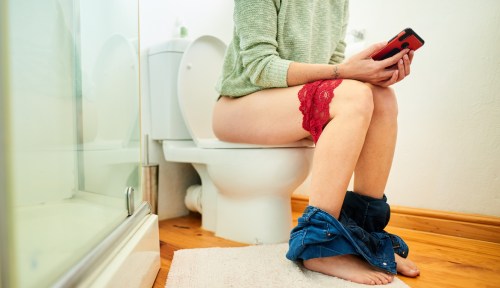Have the Past 3 Years Given You ‘Pandemic Pelvis’? Here’s What To Know About the Symptoms Experts Are Seeing Everywhere
There's been an uptick in patients coming in with pelvic floor-related symptoms that experts are calling "pandemic pelvis."

For people who have to pee a lot, the “camera off” Zoom function may have been a godsend these last three pandemic years. When nature calls, just shut that camera off for a minute, and you’re able to seamlessly pop out of and back into a meeting without disruption.
Experts in This Article
But if you’ve found yourself using this technique a lot more frequently than, say, the amount you actually went to the bathroom when you worked in an office, the comforts of working from home could be masking a problem with your pelvic floor that might have developed during the pandemic.
How to tell if you have ‘pandemic pelvis’
“Ask yourself if anything has changed in the last three years,”says Liz Miracle, PT, WCS, medical expert at pelvic floor-oriented physical therapy clinic Origin. “Do you notice that you’re now leaking urine when you didn’t used to? Or are you now having trouble going to the bathroom? Or is there something different in your sex life that is not what it used to be before? You don’t even really have to know what is and isn’t normal if you can at least just notice change in your own body.”
Recently, Miracle and other clinicians have seen a strong uptick in cases of clients coming to them with problems like frequent urination, constipation, pain during sex, and other symptoms that indicate a weak or tight pelvic floor. The pelvic floor is a hammock of muscles in your pelvis responsible for supporting your organs, and keeping it strong—but also being able to relax it—is necessary for functions like sex or going to the bathroom. Problems in your pelvis can even reverberate throughout your whole body.
“If you aren’t taking care of your pelvis and you’ve got poor posture, it’s gonna go all the way up the chain or perhaps even down the chain in terms of your spinal alignment and how things feel,” Miracle says.
So what’s behind all these pelvic woes? There’s been a confluence of factors that are leading to what experts are calling “pandemic pelvis.”
Being stationary and sitting still for long periods of time can impact your posture, mood, energy, and so much more—and it can cause strain on your pelvic floor. Stress also causes us to strain our pelvic floor muscles, which could contribute to tightness. If you had Covid or are living with long Covid, coughing also puts pressure on your pelvic floor. And finally, the pandemic may have made us more hesitant to seek treatment for something we might consider minor (like frequent urination), which compounds and worsens the problem over time.
So, what can you do about it?
If you’re experiencing symptoms, Miracle advises you to see a doctor or physical therapist, and to take the symptoms seriously.
Generally, if you want to sustain pelvic floor health, Kegels are not necessarily the answer. While strengthening those muscles is important, equally crucial is the ability to relax them. That’s why Miracle suggests practicing diaphragmatic breathing: “Place one hand on your belly, one hand on your chest and fill the air fill into the belly,” Miracle says. “Really think about that not just as air filling into the belly, but also down into the pelvic floor. I like to imagine there’s a balloon inside of your pelvis and that balloon is not only expanding up at the belly, but it’s also expanding down in the pelvis between the sit bones.”
If you’re practicing this breathing, you can even touch your perineum (the muscle between your anus and your genitals), and feel whether the muscle is relaxing. You don’t need to actively do anything to this muscle, but it’s a way to tell whether the breathing is making its way through to your pelvis. You can also practice this breathing method while in happy baby pose or another hip opener, like figure four.
Miracle wants people to know that if the pandemic has taken a toll on your life, it has probably also taken a toll on your body. Zeroing in on the pelvic floor could be one way to help, but it’s part of a larger picture of self-care.
“Whatever we’ve seen in the research that can help to reduce anxiety and depression can be very useful when it comes to pelvic floor dysfunction,” Miracle says. “Physical therapy is just one piece of the puzzle. You really have to take care of your whole self.”
Sign Up for Our Daily Newsletter
Get all the latest in wellness, trends, food, fitness, beauty, and more delivered right to your inbox.
Got it, you've been added to our email list.










